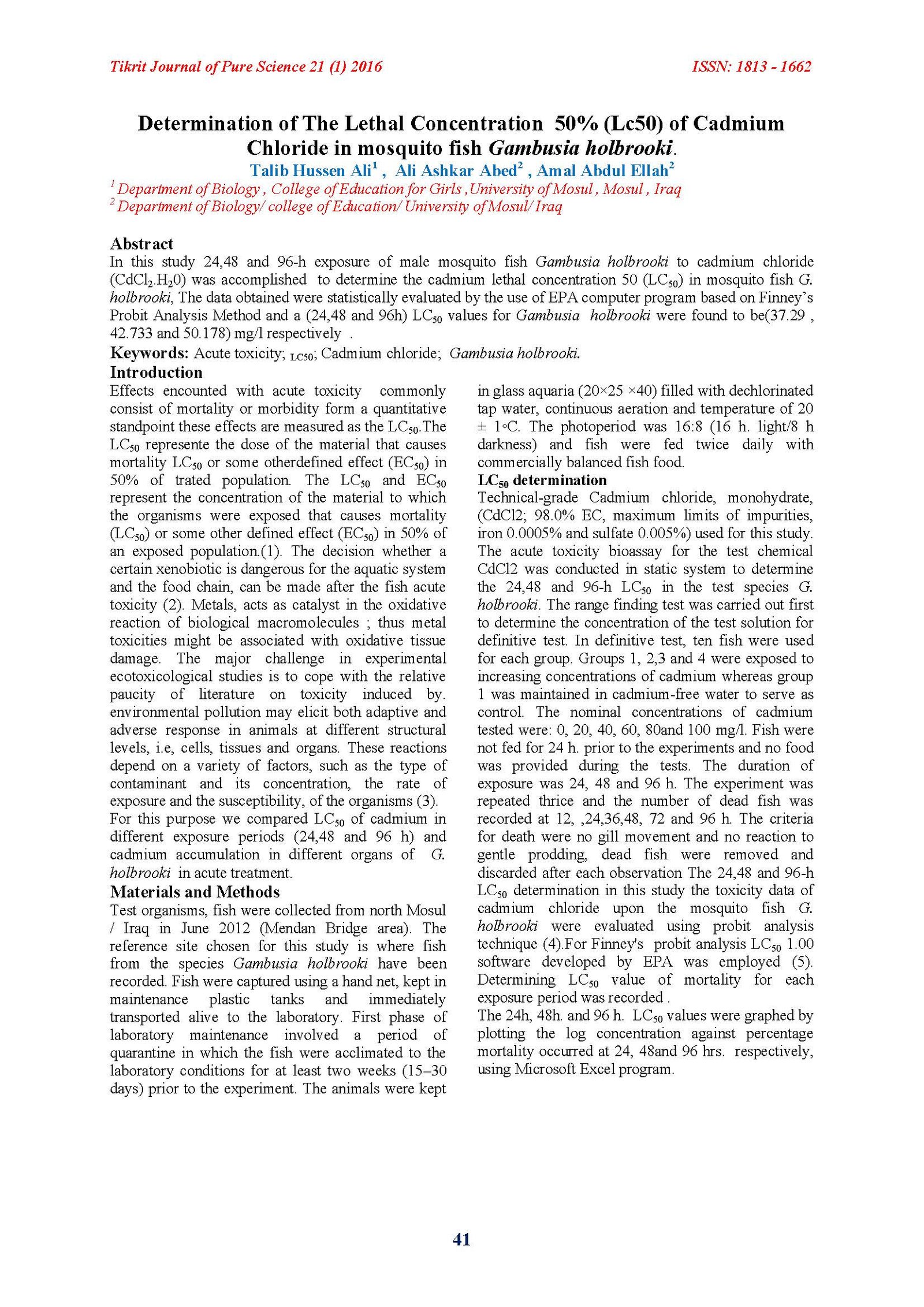Determination of The Lethal Concentration 50% (Lc50) of Cadmium Chloride in mosquito fish Gambusia holbrooki
Main Article Content
Abstract
In this study 24,48 and 96-h exposure of male mosquito fish Gambusia holbrooki to cadmium chloride (CdCl2.H20) was accomplished to determine the cadmium lethal concentration 50 (LC50) in mosquito fish G. holbrooki, The data obtained were statistically evaluated by the use of EPA computer program based on Finney’s Probit Analysis Method and a (24,48 and 96h) LC50 values for Gambusia holbrooki were found to be(37.29 , 42.733 and 50.178) mg/l respectively .
Article Details

This work is licensed under a Creative Commons Attribution 4.0 International License.
Tikrit Journal of Pure Science is licensed under the Creative Commons Attribution 4.0 International License, which allows users to copy, create extracts, abstracts, and new works from the article, alter and revise the article, and make commercial use of the article (including reuse and/or resale of the article by commercial entities), provided the user gives appropriate credit (with a link to the formal publication through the relevant DOI), provides a link to the license, indicates if changes were made, and the licensor is not represented as endorsing the use made of the work. The authors hold the copyright for their published work on the Tikrit J. Pure Sci. website, while Tikrit J. Pure Sci. is responsible for appreciate citation of their work, which is released under CC-BY-4.0, enabling the unrestricted use, distribution, and reproduction of an article in any medium, provided that the original work is properly cited.
References
1. Leblance, G.A. (2004). A textbook of modern toxicology. third edition, edited by Ernest Hodgson. Wiley & Sons. Inc. p215-224.
2. Yılmaz, M. Gul, A and Karakose,E. (2004). Investigation of acute toxicity and the effect of cadmium chloride (CdCl2 _H2O) metal salt on behavior of the guppy (Poecilia reticulata). Chemosphere 56 (2004) 375–380.
3. Wlostowski, T., Krasowska, A., and E. joint, E. (2008). Effects of dietary cadmium and polychlorinated biphenyls on metallothionein induction ,lipid peroxidation and histopathology in the kidney and liver of bank voles. Ecotoxicol . Environ. Saf. 69:403-410 .
4. Finney, D.J. (1971). Probit Analysis. Cambridge University Press, New York, p. 337.
5. EPA (1999). LC50 software program, version 1.00. Center for Exposure Assesment Modeling (CEAM). Distribution Center.
6. Vaglio, A, Landriscina, C. (1999). Changes in liver enzyme activity in the teleost Sparus aurata in response to cadmium intoxication. Ecotoxicol Environ Safe 43:111–116.
7. Li, XY.: Chung, IK.; Kim, JI;, Lee, JA. (2005). Oral exposure to Microcystis increases activity-augmented antioxidant enzymes in the liver of loach (Misgurnus mizolepis) and has no effect on lipid peroxidation. Comp Biochem Physiol 141:292–296.
8. Lesser, M.P (2006). Oxidative stress in marine environments: biochemistry and physiological ecology. Ann Rev Physiol 68:253–278.
9. Nagpure, N.S.; Anurag, D.; Ravindra, K.; Kushwaha, B.; Lakra, W. (2012).Assessment of tissue-specific effect of cadmium on antioxidant defense system and lipid peroxidation in freshwater murrel, Channa punctatus. Fish Physiol Biochem (2012) 38:469–482.
10. Trevan J. W (1927). The error of determination of toxicity. Proc Roy Soc 101B, 483-514.
11. Wiehe W.H (1973). The effect of ambient temperature on the action of drugs. Ann. Rev. Pharmacol. 13:409-425.
12. Calabrese, E.J. and Baldein, L.A. (2001). U-Shaped dose-responses in biology,toxicology, and public health. An.Rev.Public Health 22:15-33.
